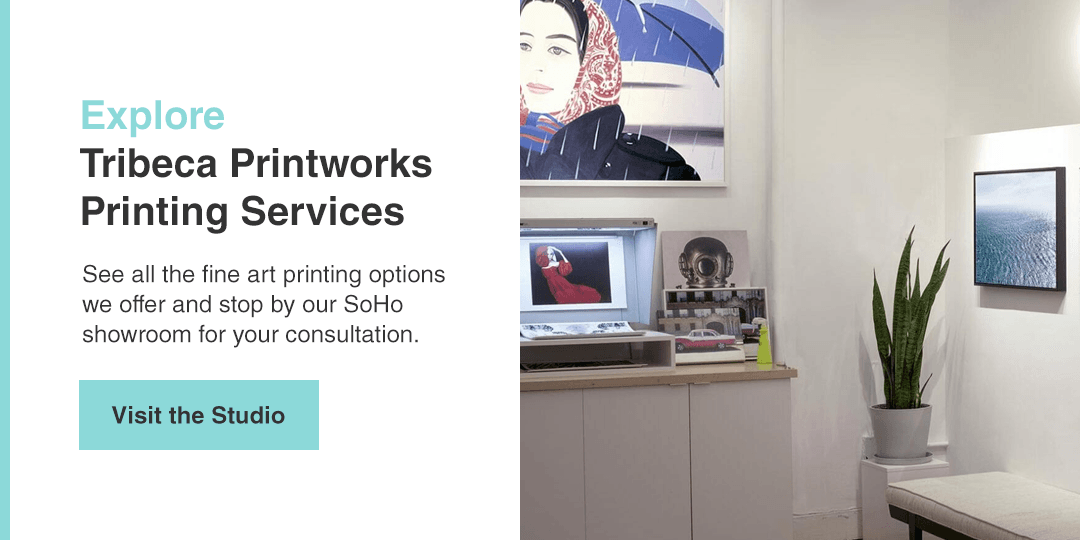What Is Fine Art Photography?

 06/30/2025
06/30/2025
by Michael McCarty
Founder, Tribeca Printworks
Fine art photography is tied to intent rather than a single technique or medium. Fine art is concept-driven, with intentional elements that express an idea, emotion or narrative. General photography is a tool that helps us document reality, while fine art photography transforms the subject to create an artistic statement.
Fine art overlaps with other types of photography, adding a layer of perspective to each genre. This type of elevated work goes beyond extreme edits or abstract effects, and it’s defined by the artist’s intention and execution. Some fine art photography examples include:
- Portraiture: As one of the most recognizable photography types, portraits can include the headshots used on a business website or ID photos on official documents. Fine art portrait photography can represent the human condition and convey a message through the subject.
- Landscape photography: You can find impressive landscapes on travel blogs or desktop backgrounds. Fine art photographers can communicate the truth of a scene or share an environmental message through their work.
- Still life: Most still life work is used for ads and product photography. Artists also create still life images that leverage the symbolism of each item, using simplicity to convey a distinctive voice.
The Core Elements of Fine Art Photography
Fine art photography builds on the following foundational principles:
Vision and Concept Development
All art pieces start with an idea. Fine art photographers envision their work around an idea and use it to develop a concept. They can plan for a single powerful image or a collection of work that conveys a message or an emotion. A concept can be explained with a single word or through a whole statement.
Storytelling and Message
Fine art photography leverages the power of visual storytelling to create images with deep meanings that convey a message. One example is the renowned portrait work of Annie Leibovitz. Her body of work mixes commercial and artistic elements, resulting in dramatic portraits that tell the story of her subjects, such as her famous portraits of John Lennon and Yoko Ono.
Cohesion and Consistency
A cohesive body of work must share a strong theme. Artists often maintain a consistent technique, style or visual language for their body of work to create individual images that add to the overall message. Images may share similar color palettes and composition techniques to serve as unique pieces of a larger collection.
Technical Mastery and Artistic Choices
While fine art photography is characterized by intent, technical abilities combine with creativity to create a compelling image and an immersive experience for the audience. Aspects like camera settings, composition strategies and post-processing techniques enable artists to realize their vision more effectively.

How to Create Fine Art Photography
Photographers don’t need a specialized degree to develop a compelling project. Fine art photography is accessible for those willing to try and learn from experience. If you are unsure of where to start, these steps can help you create your first fine art images:
1. Brainstorming and Idea Development
Fine art photography showcases your main concept and intention. You can find inspiration for your work from personal experiences, emotions, societal themes and other art, such as literature and music. Some useful methods for brainstorming ideas include mind maps, mood boards and sketching concepts.
You can refine your ideas by asking yourself:
- What do I want my images to say?
- What emotions do I want to evoke?
- What themes or symbols will I incorporate?
2. Selecting a Subject and Theme
Once you have a vision in mind, condense it to a theme. Develop your message and the motivation behind it to start making decisions. Once you’ve selected a theme, choose a subject for your photos that aligns with the message you want to convey. It can be a person, an object or a specific landscape.
There’s no limit to what you can include in your images as long as they link to your topic or message.
3. Planning the Shoot
The logistical aspects of planning a fine art photoshoot are as important as concept creation. This step is about creating the perfect environment for your vision, and the effort you’ll need to make will vary depending on your chosen technique and photography style. Some key aspects you need to prepare before shooting are:
- Pre-visualization sketch
- Location scouting
- Props and wardrobe
- Scheduling models
4. Executing Your Plans
When capturing the image, make intentional choices about lighting, composition and depth of field to add a layer of meaning through technical work. You can experiment with perspective and unconventional angles to guide the viewer’s eye through leading lines and framing. Ultimately, it’s up to you to leverage your skills and flow through the creative process.
5. Post-Processing and Editing
Now that you have your fine art photos, it’s time to select the best files and start editing. You can focus on enhancing quality with subtle tweaks while staying true to the original content or make drastic changes for a more dramatic and exaggerated transformation.
6. Building a Cohesive Body of Work
There is no set number of images needed for a project or portfolio. Selecting and curating photos will depend on the project scope, intent and how it will be displayed. The best way to pin the right number for your work is to choose the pieces that effectively convey your artistic statement and enhance the impact of the narrative.
Why Choose Tribeca Printworks for Your Fine Art Photography Prints?
Tribeca Printworks offers a wide range of possibilities for fine art photography printing. We have decades of experience providing customized solutions for photographers and artists. Our expert team helps bring your vision to life through a wide variety of materials and finishes, providing quality, flexibility and durability for your fine art.
We offer specialized fine art printing and framing services, taking the time to understand your needs and help you choose the best printing method that adapts to your style and budget. Our museum-quality giclee prints are carefully managed and color-calibrated to achieve outstanding results.
Bring Your Work to Life With Museum-Quality Printing
Tribeca Printworks is your specialized partner for fine art consultation, print, frame and fabrication needs. Upload your files to place an order and our software will analyze the file’s resolution to calculate available sizes. You can also contact our team for more information about our museum-quality printing services.
